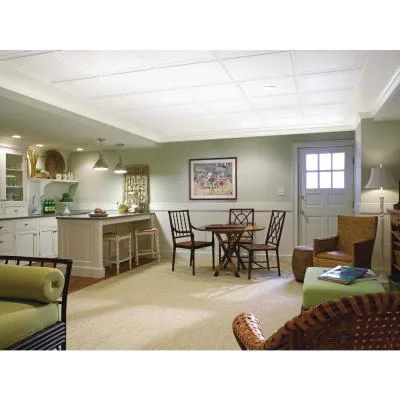National Average Improvement and Repair Cost
Pro
DIY
Hours:
15
25
Cost:
$ 1482
$ 365
Would you do this project? According to our survey, 67% of respondents preferred DIY compared to hiring a pro.

The average price to Install a Suspended or Drop Ceiling noted above is cost data to compare a contractor’s estimate with doing it yourself.
How much does it cost to install a suspended or drop ceiling system? Compare $1,482, what a contractor charges with $365, what a handy homeowner can do the job for and save 75 percent.
Make the most of an unfinished basement and take advantage of untapped living and storage space. A suspended or drop ceiling is the solution to cover up the maze of electrical wires, plumbing lines, and heating ducts.
Suspended or drop ceiling tiles are 24-inch square or 24- by 48-inch panels that fit into a metal grid; the system is also used to lower or level an existing ceiling, often a concern in large older homes.
The metal grid is permanently fastened to an old ceiling or from exposed floor joists; the ceiling panels are then placed in the grid. That means a damaged panel can be quickly and easily replaced, and it’s no trouble to access the lines and wires for repair work. Compared to a permanent drywall ceiling, this removability factor is a plus.
A contractor will charge $1,482 to install a drop ceiling in a 15-by-20-foot room using 24-inch square panels, which includes the labor and material. If you have some carpentry experience you can buy the grid and panels for $365, saving 75 percent. The job will cost more if you incorporate recessed or surface-mounted lighting. And it’s not a trivial job, figure you’ll spend the better part of a weekend completing the ceiling installation.
Here are instructions from Armstrong to Install Ceiling Panels.
When you’re planning a ceiling in a room, figure you need at least a 7-foot ceiling height. The channels usually require about six inches of space below the lowest obstacle or pipes in the ceiling, which gives you a finished ceiling height of about 6 ½-feet. That’s the minimum ceiling height for most building codes.
You’ll need the following tools and equipment: tape measure or measuring rule, straight edge, hammer, carpenter’s level, utility knife, tin snips, line wire cutting pliers, string and chalk, safety glasses, and a ladder (two, if you have a helper). You’ll spend the most time planning the grid layout and installing it; inserting the tiles goes quickly, which completes the job.
To make layout easier and be assured that the ceiling is level, rent or buy a laser level.
That sums it up. Knowing the average cost to install a drop ceiling lets you compare doing it yourself with what you can expect to pay a contractor. To customize the cost to where you live add your ZIP Code in the cost box.
